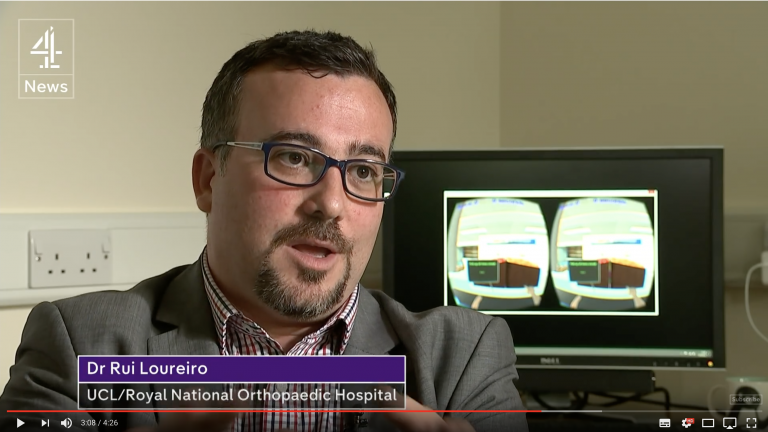Using Virtual Reality and Haptic Robots to alleviate Phantom Limb Pain
30 January 2018
Researchers at the UCL Aspire CREATe Centre are conducting a pilot study to improve pain relief for patients.

The team were recently featured on a Channel 4 News segment which explores how advances in virtual reality can be used in a clinical setting. Watch the video segment here.
Approximately 5,000 amputations are carried out in the UK every year and eight of ten of these patients may suffer from phantom limb pain.
The amputation of a limb is performed for three main reasons:
- The limb has been affected by gangrene
- The limb poses a life-threatening danger to the person’s health
- The limb has experienced serious trauma
Phantom Limb Pain is a common problem for amputees and can cause significant distress. The symptoms of phantom limb pain can range from mild to severe. Some people have described brief “flashes” of mild pain, similar to an electric shock, that last for a few seconds. Others have described constant severe pain.
It is thought that when the brain is ‘starved’ of feedback from a missing limb, it sends a painful message to get you to move it. As the pain is being experienced by a limb which is no longer attached to the body traditional pain relief techniques and medications may not work.
A research study is currently being conducted by scientists at the Aspire CREATe Centre, part of the UCL Institute of Orthopaedics and based at the Royal National Orthopaedic Hospital in Stanmore, to test the effectiveness of new pain-relief methods.
The study, funded by the UK Ministry of Defence through a contract with the Defence Science and Technology Laboratories and partnered with Middlesex University, is using state of the art virtual reality (VR) in conjunction with a robotic training system to create a realistic illusion for the wearer. The virtual reality environment has been under development by the team for over 3 years.
The primary aim of this study is to measure the effectiveness of an immersive Haptic system that combines a visual surrogate for the missing limb with haptic feedback (VR + Haptics) on reducing phantom limb pain, as compared with the same therapy without the haptic feedback (VR only).
Three technological elements summarise the innovation:
- Direct physical contact to the haptic device
- Mapping of the information from the device to the virtual representation of the physical limb
- An application that maintains challenge and interest to the individual
Haptics (pronounced HAP-tiks) is the science of applying touch (tactile) sensation and control to interaction with computer applications. (The word derives from the Greek haptein meaning “to fasten.”) Each patient who participates in the clinical trial will undergo an intensive three week training course. This involves visiting the Aspire CREATe Centre daily to practice scenarios of increasing difficulty in the virtual reality environment and keeping a diary to record all changes to their symptoms. It is hoped that the intensive training period will provide longer-lasting pain relief to patients.
The study is hoping to have recruited 20 patients from the Royal National Orthopaedic Hospital and other associated partner rehabilitation centres across England by the end of 2016.
Summary of Details:
Title: “Research into Phantom Limb Pain: A pilot Study on a Virtual reality Robot-mediated Technique to Decrease phantom limb pain”,
Who & Where: Dr Rui Loureiro (Aspire Senior Lecturer, UCL), Mr Peter Snow (PhD student / Research AssitantAssistant, Middlesex University/ UCL), Prof Richard Comley (Professor, Middlesex University), Dr Imad Sedki (Consultant in Rehabilitation Medicine, Royal National Orthopaedic Hospital), Dr Marco Sinisi (Consultant Orthopaedic Surgeon, Royal National Orthopaedic Hospital)
Contact: R.Loureiro@ucl.ac.uk
 Close
Close

